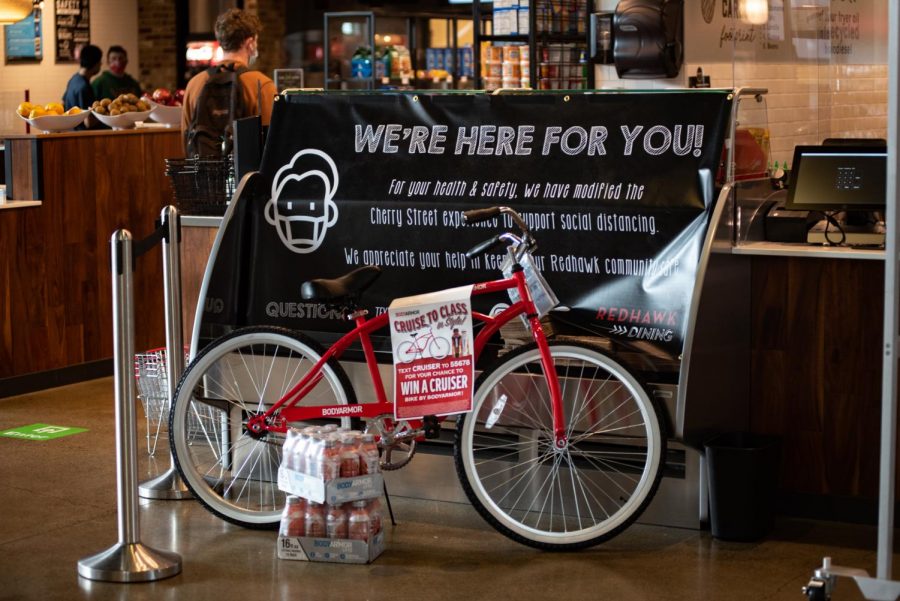Cherry Street Market Tightens COVID-19 Regulations
In the wake of the COVID-19 pandemic, Seattle University’s main eatery has redesigned its layout to allow for social distancing. Most students at Seattle U who rely on Cherry Street Market are now taking precautions when eating by keeping to themselves or retiring to their own rooms after picking up food. Now featuring a streamlined walkthrough, the two tracks lead its mask-wearing customers through a circuit which is micromanaged by social distancing stickers on the floor.
Following new regulations set forth by Gov. Jay Inslee, Chartwells made certain that seating at Cherry Street Market was also in accordance with COVID-19 guidelines. Seattle University sent out an email on Oct. 2 alerting students about new protocols and directions.
On behalf of Housing and Residence Life (HRL), Dean of Students James Willette, explained in the email that dining facilities could only offer takeout meals or single seating. The only exception to single seating was in regards to roommates, who are allowed to sit at the same table while dining. Additionally, the email noted that athletics teams and other groups were not allowed to dine together.
Most of the students that spoke to The Spectator had shown up to eat with their roommates, while others appeared in small groups of three or four. These students clumped together in neat pods while collectively waiting for meals.
Polina Chowdhury, a second-year biology major, shared her daily experience at Cherry Street.
“I didn’t really eat in C-Street too much because I felt it was a little too crowded for my safety,” Chowdhury said. “It just feels a little weird right now to take off a mask in front of everyone with everything going on, even while eating.”
She expanded on her earlier hesitations.
“We’re told tables are constantly cleaned by Chartwells about every 15 minutes, but I don’t know how realistically that could be happening if we’re sitting down and then somebody else takes that seat when we leave.”
She also expressed concern about the consolidation of other food services. Cherry Street Market has become the only eatery on campus. The Bottom Line in Pigott and The SideBar have remained closed. The Cave was also shut down. To accommodate, Cherry Street Market now features a small section dedicated to household goods which would have been sold in the Cave.
For students living on campus, options for meals have become limited. Maggie Johnson, a second-year environmental science major, shared this sentiment. She shared her overall thoughts on safety at the Cherry Street Market.
“I don’t really have any other option for eating, but, I guess it’s safe,” Johnson said. “Students in C-Street do a pretty good job of following social distancing rules. The fact is, Chartwells doesn’t have much open because that would cause crowding. There isn’t anywhere else to pick up food, so I’m thankful for those who are complicit.”
Valentina Bernal, a second-year business data analytics major, felt comfortable picking up her food from the Cherry Street Market.
“I feel like it’s usually pretty empty,” Bernal said. “They have pretty good social distancing measures set up. Most people order ahead, get their food, and go back to their rooms.”
With Cherry Street Market no longer featuring more than single seating indoors, groups seeking to eat together have moved outside to enjoy the weather and sit out on the Pigott Pavilion grass.
According to the students, Chartwells seemed to pass their criteria of a clean cafeteria. The seating restriction, along with the inside of the Cherry Street Market, was well managed. Students reported few rush hours and rare situations where rules were not followed. While the concerns of some students were centered around the lack of a salad bar, all concluded that Chartwells had done well to adapt the Cherry Street Market in response to COVID-19.
The overall consensus suggested that few students ate within the bounds of Cherry Street Market, instead getting takeout and returning to their residence halls. Those who sat outdoors, while deciding to ignore the governor’s orders, restricting interaction with non-roommates, followed social distancing rules when indoors or interacting with others.


